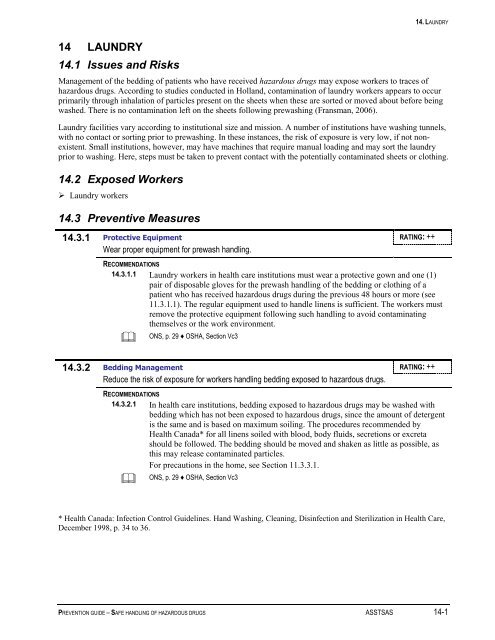Prevention Guide - Safe Handling of Hazardous Drugs - Irsst
Prevention Guide - Safe Handling of Hazardous Drugs - Irsst
Prevention Guide - Safe Handling of Hazardous Drugs - Irsst
You also want an ePaper? Increase the reach of your titles
YUMPU automatically turns print PDFs into web optimized ePapers that Google loves.
14. LAUNDRY<br />
14 LAUNDRY<br />
14.1 Issues and Risks<br />
Management <strong>of</strong> the bedding <strong>of</strong> patients who have received hazardous drugs may expose workers to traces <strong>of</strong><br />
hazardous drugs. According to studies conducted in Holland, contamination <strong>of</strong> laundry workers appears to occur<br />
primarily through inhalation <strong>of</strong> particles present on the sheets when these are sorted or moved about before being<br />
washed. There is no contamination left on the sheets following prewashing (Fransman, 2006).<br />
Laundry facilities vary according to institutional size and mission. A number <strong>of</strong> institutions have washing tunnels,<br />
with no contact or sorting prior to prewashing. In these instances, the risk <strong>of</strong> exposure is very low, if not nonexistent.<br />
Small institutions, however, may have machines that require manual loading and may sort the laundry<br />
prior to washing. Here, steps must be taken to prevent contact with the potentially contaminated sheets or clothing.<br />
14.2 Exposed Workers<br />
‣ Laundry workers<br />
14.3 Preventive Measures<br />
14.3.1 Protective Equipment RATING: ++<br />
Wear proper equipment for prewash handling.<br />
RECOMMENDATIONS<br />
14.3.1.1 Laundry workers in health care institutions must wear a protective gown and one (1)<br />
pair <strong>of</strong> disposable gloves for the prewash handling <strong>of</strong> the bedding or clothing <strong>of</strong> a<br />
patient who has received hazardous drugs during the previous 48 hours or more (see<br />
11.3.1.1). The regular equipment used to handle linens is sufficient. The workers must<br />
remove the protective equipment following such handling to avoid contaminating<br />
themselves or the work environment.<br />
<br />
ONS, p. 29 ♦ OSHA, Section Vc3<br />
14.3.2 Bedding Management RATING: ++<br />
Reduce the risk <strong>of</strong> exposure for workers handling bedding exposed to hazardous drugs.<br />
RECOMMENDATIONS<br />
14.3.2.1 In health care institutions, bedding exposed to hazardous drugs may be washed with<br />
bedding which has not been exposed to hazardous drugs, since the amount <strong>of</strong> detergent<br />
is the same and is based on maximum soiling. The procedures recommended by<br />
Health Canada* for all linens soiled with blood, body fluids, secretions or excreta<br />
should be followed. The bedding should be moved and shaken as little as possible, as<br />
this may release contaminated particles.<br />
For precautions in the home, see Section 11.3.3.1.<br />
<br />
ONS, p. 29 ♦ OSHA, Section Vc3<br />
* Health Canada: Infection Control <strong>Guide</strong>lines. Hand Washing, Cleaning, Disinfection and Sterilization in Health Care,<br />
December 1998, p. 34 to 36.<br />
PREVENTION GUIDE – SAFE HANDLING OF HAZARDOUS DRUGS ASSTSAS 14-1

















